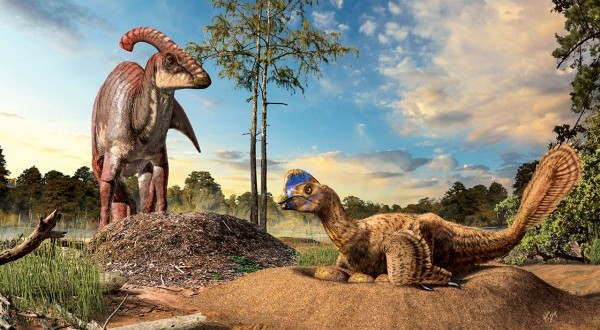The way dinosaurs nested could very well be the reason behind the evolutionary success of birds, according to new research from the University of Calgary.
Kohei Tanaka, a PhD student in the Faculty of Science, recently published a paper in PLOS ONE where he and his co-authors demonstrate, for the first time, the link between dinosaur eggshell porosity and different nesting types. The article establishes how dinosaur egg nesting styles correlate with current crocodile covered nests as well as modern, exposed open-bird nests.
“Dinosaur nest structures and nesting materials are usually not preserved in the fossil record,” says Tanaka. “In the past, this lack of data has made working with dinosaur eggs and eggshells extremely difficult to determine how dinosaurs built their nests and how the eggs were incubated for hatching young.”
Study compared egg porosity of dinosaurs to birds and crocodiles
Working under the supervision of Darla Zelenitsky, assistant professor and a world expert in dinosaur eggs and nesting sites in the Department of Geoscience, Tanaka conducted an in-depth study of the egg porosity of 30 different dinosaur species. He compared those results with the egg porosity of 120 species of birds and crocodiles, which are the closest living relatives to dinosaurs.
“Brooding birds, which incubate their eggs in open nests, tend to have low eggshell porosities compared to crocodiles and megapode bird species that incubate in buried nests,” explains Tanaka.
The study’s results show that most dinosaurs, including the long-necked sauropods, primitive meat-eating theropods and possibly plant-eating ornithischians, produced low porosity eggshells and therefore, were highly likely to bury their eggs in nests much like their crocodile predecessors.
Shift in nest type and incubation style during evolution towards birds
Advanced theropods like the maniraptorans featured high porosity eggshells, suggesting that they laid and incubated their eggs in open nests in a similar fashion as their most closely related living birds. Other paleontological evidence also revealed that these early open-nesters did, however, still partly bury their eggs.
The researchers concluded that it was probably not until modern-looking birds that open nests with fully exposed eggs came to be, meaning that there was a shift in the type of nest, and probably incubation style of dinosaurs, during their evolution toward birds.
“Because buried nests needed to be built and incubated on the ground, open nesting and brooding may have allowed advanced theropods —including birds — to incubate eggs in a greater diversity of locations and occasionally away from ground predators, potentially contributing to their evolutionary success,” says Zelenitsky, referring to birds as the most diverse living species with more than 10,000 unique types.
Laying the groundwork for further research into dinosaur nesting habits
It is anticipated that this research will pave the way for further inquiries into the world of dinosaurs’ nesting habits.
“With a large amount of data gathered though Tanaka’s diligent work on the eggs of living and fossils animals, we plan to dig even deeper on new questions such as how long it took for dinosaurs to hatch their eggs,” says Zelenitsky.
Agencies/Canadajournal
 Canada Journal – News of the World Articles and videos to bring you the biggest Canadian news stories from across the country every day
Canada Journal – News of the World Articles and videos to bring you the biggest Canadian news stories from across the country every day




If scientists have found birds including parrots, penguins and owls buried in dinosaur layers, how do we know birds evolved from reptiles? Maybe dinosaurs evolved from birds. Or maybe they both came from a common ancestor? What came first, the chicken egg or the reptile egg?
Evolution didn’t happen. Watch Kent Hovinds movies.